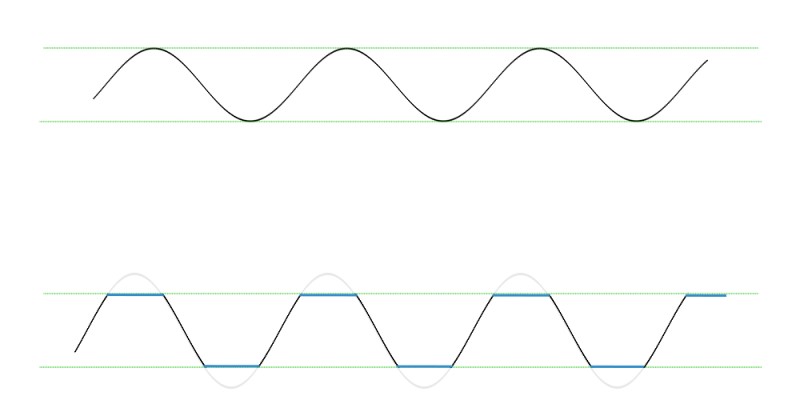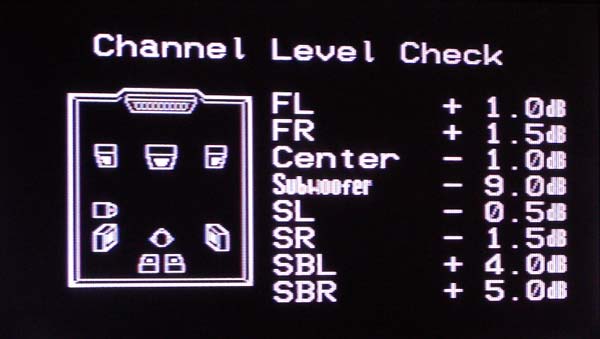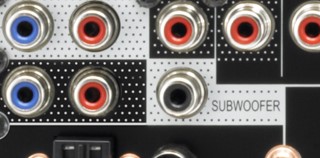Subwoofer Output Clipping: Real Problem or Urban Legend?
There are some pieces of wisdom online that just won’t die. Sealed subwoofers are musical and ported subwoofers are boomy. Denons are clinical and Yamahas are warm (or is it the other way around, I can never remember). Somehow, these pearls of wisdom take root and they are harder to kill than a weed growing through a crack in your driveway. One of the newer ones I’ve seen is that you should never have the trim level on your receiver in the positive numbers. Why? Because a positive number will “clip” the subwoofer output. Well, that sounds bad, doesn’t it? But what does it mean, does it really happen, and what should you really do? Let’s break this down.
What is Clipping?
A “clipped signal, from a subwoofer output or anywhere else, is one that is somehow deformed. If you think of a sound wave, the tops and bottoms are cut off. Like this:

Those cut off tops and bottoms are bad. They can damage your speakers and cause distortion. Your subwoofer cannot detect that the signal is clipped and will try to recreate the soundwave it was sent. It won’t be able to, and the driver can overheat and damage itself trying. So, we definitely don’t want the subwoofer output to clip. But this begs the question. Is the subwoofer output clipping?
What are Trim Levels?
In your receiver, there are trim levels for all your speakers, including your subwoofer(s). The trim levels allow you to adjust the volume on all those speakers up or down. Depending on the manufacturer of receiver or processor, you’ll have a 10 or 12dB range. So, from -12dB up to +12dB (or -10dB to +10dB). For your speakers, it allows you to adjust the volume directly (if they are connected to your receiver) to compensate for distance and speaker sensitivity. All of this so that at your main listening position all the speakers will play at the same volume when asked.
For your subwoofer (or any speaker controlled by an external amplifier), voltage is sent out of the pre-out to the amplifier. This is the same signal that would be sent to the internal amplifier, except it is going to an amp outside itself. That amplifier then interacts with the speaker to produce the sound. The trim levels, again, do the same thing. The volume is adjusted up or down based on the location and capabilities of your subwoofer. The difference? Your subwoofer also has a volume control.
The Subwoofer Gain
The gain knob on your subwoofer adjusts the volume level of your subwoofer. The higher you set your volume knob, the lower the trim level will be on your receiver. The same for the opposite. In the end, the gain knob and the trim level interact.

When you run your automatic room setup program, you’ll often see a prompt to adjust your subwoofer gain. This is so that the gain knob is set to a level that is close to the target volume. This should allow your receiver to set the trim level very close to zero. A zero setting gives you the most leeway to adjust the volume of the subwoofer up or down based on personal preference. If your volume knob setting on the subwoofer forces the trim level to be near an extreme (+/-10 dB), then you can really only adjust the trim level in one direction. Having it at zero gives you maximum flexibility.
Subwoofer Output Clipping
Now that we understand what is actually happening, what is the concern with subwoofer output clipping? The thought is that the actual signal between the receiver/processor and the subwoofer can be clipped by setting the trim levels to a positive number. This just isn’t the case. Most receiver manufacturers create their pre-outs (subwoofer or other speakers) with a general standard of output voltage (usually between 1.2-2.0 volts). Subwoofer and home theater amplifier manufacturers know this and build their inputs to match. Or, more likely, build their amps so that they can accept many different voltages.
If you are really worried about clipping, then you can look at the specifications for your subwoofer output on your receiver and the input on the sub amplifier. You want to output maximum voltage from the receiver to meet or exceed the input maximum voltage at the amplifier. In most cases, you won’t be able to find out this information directly from the manual or specification sheet. You’ll likely have to reach out to the manufacturers directly for that information. Once, you do, you can do the simple math.
That said, it really only comes into play when your receiver is at or near its maximum output. If your volume knob on the back of your subwoofer isn’t anywhere near maximum during the calibration process (and this will often be the case because of all the other reasons you buy a subwoofer), this voltage mismatch really doesn’t matter.

Can the Subwoofer Output Clip?
Of course it can. There are a few situations where we can see this happening. If you are using an esoteric receiver or preamp, the output voltage could clip. We’ve also seen people sum more than one output (usually using an external device like a miniDSP) that causes the signal to clip. But these situations are highly unlikely and don’t apply to the vast majority of consumers. Did you buy a regular subwoofer and consumer-level receiver? Then hook them up and call it a day. If you built your own sub, or bought an esoteric piece of AV gear, you may have more to worry about.
The Listening Test
In most of the cases where we see people ask about subwoofer output clipping, it goes something like this. “I hooked up my receiver and subwoofer and everything sounded fine. But I was reading on this forum and checked my trim level and it is positive. Should I lower it?”
The answer was in the question. Clipping isn’t something that is subtle. It sounds obviously bad. You won’t say to yourself, “Hey, I wonder what that sound is?” You’ll say, “My lord, what was THAT!?!” Clipping is unnatural and it sounds it.
Adjusting the trim level of your receiver’s subwoofer output away from positive numbers to avoid potential clipping is unnecessary. If you aren’t hearing distortion or horrible noises, your subwoofer isn’t clipping. Follow the directions for setting up your subwoofer and you’ll be fine.


